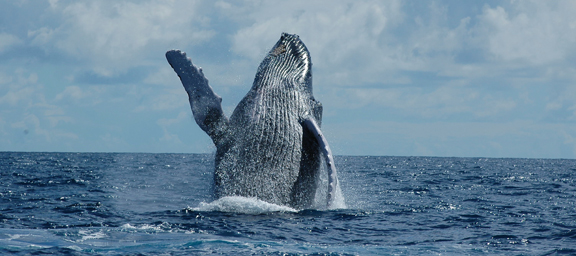By Raquel Gilliland; Sea of Change Intern
Welcome to our “Creature Features” where we introduce a new sea creature that is special and unique. This featured creature is a gentle giant commonly known as the humpback whale (Megaptera novaeangliae – which means “giant wings of New England). They are mammals in the family Balaenopteridae, also known as rorquals. Rorquals such as humpback whales have long, filtering plates of baleen that vertically line the inside of their mouths.

Humpbacks feed on crustaceans and krill by opening their mouths at the surface to gulp gallons of water. They then filter the water through slits in their baleen plates and the krill sticks to these plates inside their mouths. Although small, krill is the main food source for humpback whales allowing them to grow an average of 40-60ft long and weighing about 30-40 tons!
As a migratory species, humpback whales travel great distances between their feeding grounds and their calving grounds. They usually travel in groups called “pods” of 2-5 whales. In the summer months, they travel to temperate and polar waters to feed on massive amounts of krill; in the winter months, they mate and give birth to their young in warmer, calm tropical waters.
Humpbacks are currently listed as a species of “least concern” by the IUNC Red List of Threatened and Endangered Species with populations predicted to keep increasing. However, this was not always been the case as humpback populations drastically declined at the start of the 20th century due to the whaling industry. As a response to the population declines, the United States made it illegal to hunt, harm, or disturb humpback whales in 1973. With this increased protection and the creation of marine protected areas such as the Hawaiian Islands Humpback Whale Marine Sanctuary, along with increased public outreach/education humpback populations have made a significant comeback. There are still challenges to keeping humpback whale populations thriving, which is why it is important for international conservation efforts to continue. Follow this link to learn how the Sea of Change Foundation has supported humpback whale monitoring around the waters of New York.




